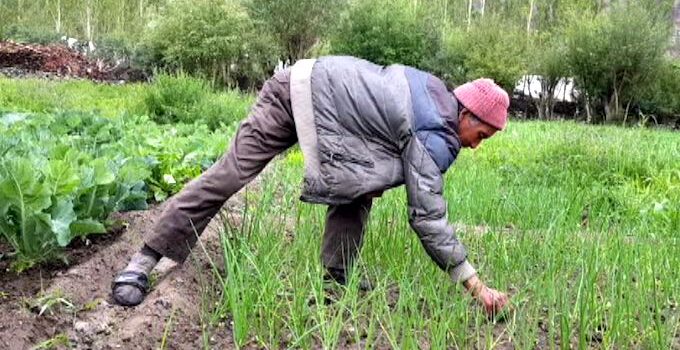
Climate change impacts agriculture in Ladakh
| Summary India Climate Dialogue report |
Ladakh is a cold desert** and its arid climate makes conditions harsh for agriculture. Almost 90% of farmers in Ladakh are dependent on snowmelt water for irrigation. Scientists say the water problem in this area is mainly due to climate change. There has already been a 3 degree Celsius rise in average temperature of Ladakh in the past four decades. This has caused less snowfall and faster snowmelt in the higher regions.
•
In western Himalayas, the glacier cover has reduced by almost 20% and some of the glaciers are facing an existential threat. Experts say global warming has affected the rainfall pattern adversely in these higher regions.
**Read more about desert climate
Agriculture productivity has dropped by 30% to 50%
Earlier there was very heavy snowfall in this area. Until 20-30 years ago, the Khardung-La pass would remain close for six months. So, if a car would g from here to Leh, it used to stick there only.
Lesser snowfall affects health of rivers and streams. Agriculture productivity has dropped by 30% to 50%.
The numbers are alarming. There was 50% to 80% deficit in annual precipitation in Ladakh between 2013 and 2017, and 2016 was a year of record low rain.
Not just agriculture, animal husbandry is also affected. Dry pastures give little fodder.
Every problem brings a opportunity
Vibha Dhawan, an agricultural scientist with Delhi-based The Energy and Resources Institute (TERI), says that this problem is not limited to Ladakh. However, high-altitude regions like Ladakh are surely more vulnerable because of geography and arid climatic conditions. “Water (scarcity) everywhere in the world and more so in India is going to be a problem. We have glaciers, which unfortunately are melting faster. That might give you initially an impression that there is more availability of water but ultimately the source is depleting.”
•
“My technique is simple, and it is all about slowing down the speed of current during winters. It helps to solve the problem of water for irrigation but there is an additional advantage of artificial glacier,” Norphel told indiaclimatedialogue.net. “It becomes a good source of groundwater recharge, which is much needed in Ladakh as tourism is growing and people are extracting groundwater for daily use.”
•
There is another way to conserve water, which is embedded in tradition in Ladakh. Many households use dry latrines in their homes, which reduce the water consumption for sanitation. Human waste is covered by soil, which helps in decomposing and turns it in manure to be used in fields.
Climate change has a flip side
•
There is another aspect of global warming, which is termed as a positive effect of climate change. Now it is possible to grow several crops and vegetables in Ladakh, which was impossible earlier. Farmers nowadays grow capsicum, cucumber, cauliflower, tomatoes, okra and even watermelon. “Rise in temperature has made this possible here. Earlier you couldn’t think of growing them here at all,” says Namgyal of Hunder village, with a hearty laugh.
So, is climate change good or bad news for the farmers in these high-altitude regions?
•
“Climate Change is not going to have a uniform impact everywhere,” said TERI’s Dhawan. India being a large country with different agro-climatic zones, somewhere there would be gains, while other areas stand to lose out. But overall, “India is going to be a loser, rather entire South Asia,” she said.
While the debate continues, effects of climate change need to be examined closely by government and people to act upon.